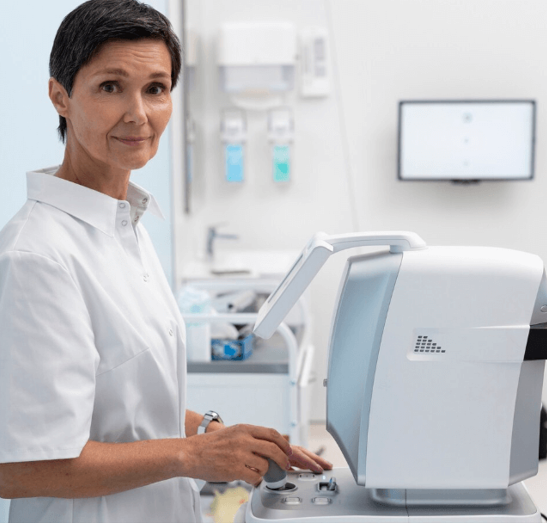Treatment Overview
The Precision-Guided Robotic Hysterectomy (PGRH) in Korea is a cutting-edge surgical procedure that combines robotic-assisted hysterectomy with precision-guided technology to achieve optimal surgical accuracy and patient outcomes. This minimally invasive approach uses advanced robotics integrated with 3D high-definition imaging, fluorescence guidance, and AI-assisted navigation to ensure safe, efficient, and highly precise removal of the uterus.
Korea is a world leader in robotic gynecologic surgery, offering internationally recognized programs for PGRH. These procedures are performed in state-of-the-art hospitals with experienced surgical teams who specialize in robotic systems such as the da Vinci® Surgical System, enabling unparalleled precision and reduced surgical trauma.
Purpose & Benefits
Purpose:
- Treat uterine conditions requiring hysterectomy with enhanced precision
- Minimize damage to surrounding tissues and nerves
- Improve recovery time and patient comfort
- Optimize surgical outcomes and preserve pelvic function where possible
Benefits:
- Exceptional precision with robotic-assisted instrumentation
- Superior visualization of pelvic structures with 3D high-definition imaging
- Reduced blood loss and minimized trauma to surrounding tissues
- Smaller incisions, less pain, and faster recovery
- Shorter hospital stays and improved cosmetic results
- Lower complication rates due to enhanced surgical accuracy
Ideal Candidates
PGRH is ideal for women who:
- Have uterine fibroids, adenomyosis, endometriosis, or uterine prolapse
- Require hysterectomy for benign or early malignant conditions
- Desire a minimally invasive approach with the highest level of precision
- Wish to reduce the risk of postoperative complications
- Are in good overall health and suitable for robotic-assisted surgery
Candidates undergo thorough preoperative evaluation, including pelvic imaging and individualized surgical planning.
Possible Risks & Complications
Although robotic hysterectomy is among the safest and most precise surgical options, possible risks include:
- Minor bleeding or infection
- Injury to surrounding organs (bladder, bowel, ureters)
- Anesthesia-related complications
- Temporary urinary or bowel changes
- Rare adhesions or nerve irritation
Korea’s advanced robotic platforms and highly trained surgeons significantly reduce these risks.
Surgical Techniques Used
Korean hospitals utilize the most advanced robotic-assisted surgical techniques for precision-guided hysterectomy:
- Robotic-Assisted Laparoscopic Hysterectomy: Allows fine motor control and high precision for delicate tissue dissection.
- Fluorescence-Guided Imaging: Enhances visualization of vascular and nerve structures.
- 3D High-Definition Visualization: Improves accuracy and depth perception during surgery.
- AI-Assisted Surgical Navigation: Provides real-time guidance and precision.
- Single-Port Robotic Access: Minimizes scarring while maintaining surgical accuracy.
These innovations make Korea one of the most advanced destinations for robotic hysterectomy worldwide.
Recovery & Aftercare
Recovery after PGRH is generally faster and smoother compared to open surgery, thanks to the minimally invasive approach and precision guidance. Hospital stays usually range from 1–2 days, with patients resuming light activity within a week.
Postoperative care includes:
- Pain management and wound care
- Avoidance of heavy lifting and strenuous activity for 4–6 weeks
- Pelvic floor rehabilitation (if applicable)
- Regular follow-up visits to monitor healing and function
- Emotional and hormonal support if required
Korean medical centers offer comprehensive postoperative programs, including physiotherapy, nutritional guidance, and lifestyle coaching to support optimal recovery.
Results & Longevity
PGRH delivers excellent long-term outcomes, including:
- Complete treatment of gynecologic conditions
- Preservation of surrounding structures and pelvic function
- Reduced complication rates
- Faster recovery and improved quality of life
- Long-lasting symptom relief
Korean surgical teams focus on both the effectiveness of the procedure and the patient’s long-term health and wellbeing.
Treatment Process in Korea
Korea’s precision-guided robotic hysterectomy program follows a structured and patient-focused approach:
- Comprehensive Preoperative Evaluation: Includes pelvic imaging (MRI, ultrasound), hormonal testing, and consultation.
- Customized Surgical Planning: AI-assisted planning based on patient anatomy and condition.
- Precision-Guided Robotic Surgery: Utilizing high-definition imaging and advanced robotics for optimal accuracy.
- Postoperative Recovery: Tailored rehabilitation, including physiotherapy, nutrition, and emotional support.
Korea offers international patient services, multilingual support, luxury recovery facilities, and access to the most advanced robotic surgery systems, making it a premier destination for PGRH.
Cost Range
The cost of a Precision-Guided Robotic Hysterectomy in Korea generally ranges between USD 11,000 and 20,000, depending on:
- Complexity of the procedure
- Hospital and surgeon reputation
- Use of advanced robotic and imaging technologies
- Extent of postoperative care and rehabilitation
This price usually includes preoperative assessments, surgery, anesthesia, hospitalization, and follow-up care. Korea offers high-quality robotic hysterectomy at competitive prices compared to other leading healthcare destinations.
Popular Clinics
- Samsung Medical Center (Seoul): Leader in robotic-assisted gynecologic surgery with precision-guided technology.
- Asan Medical Center (Seoul): Renowned for complex robotic hysterectomy procedures with nerve preservation.
- Severance Hospital (Yonsei University Health System, Seoul): Pioneers in precision-guided robotic surgery.
- CHA Gangnam Medical Center: Specializes in minimally invasive, precision-guided robotic gynecologic procedures.
- Ewha Womans University Medical Center: Offers patient-centered robotic hysterectomy programs with advanced technology and holistic recovery support.




